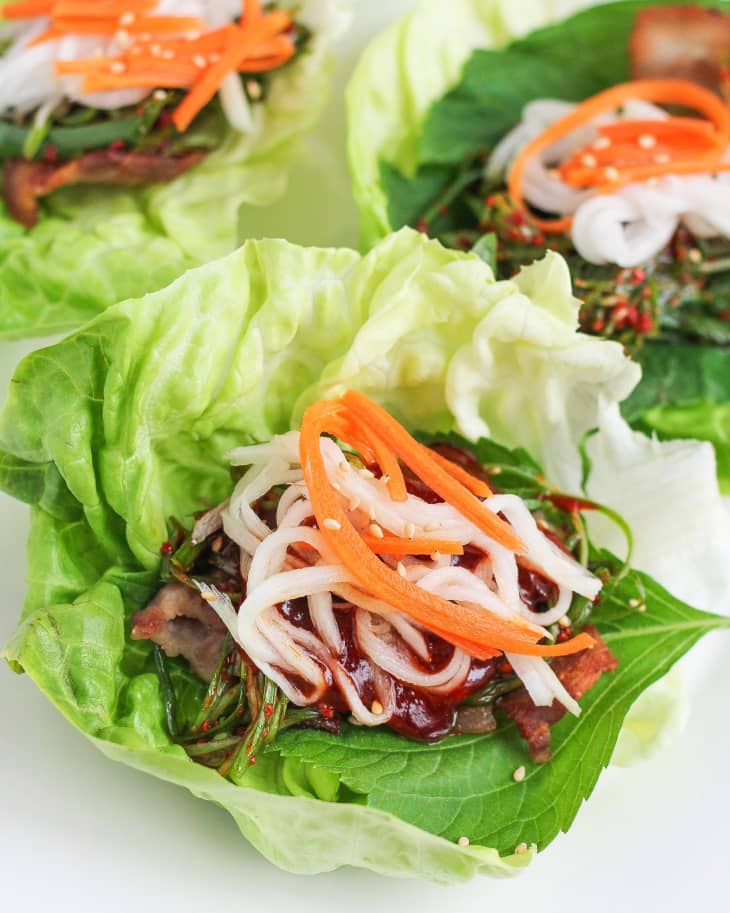Recipe: Pork Belly Lettuce Wraps

A trip to the Korean market is always fun when I’m getting ready to entertain or simply preparing a weeknight meal. We love Korean food at our house, and pork belly lettuce wraps are always a fun and active way to serve delicious, flavorful food, no matter the occasion.
These lettuce wraps celebrate the popular Korean dish Samgyeopsal Gui, which simply means grilled pork belly. Koreans traditionally eat Samgyeopsal while grilling the meat themselves at the table. The pork is then placed into a piece of lettuce topped with a Korean perilla leaf, a delicious green onion salad and then either ssamjang or a sweet and spicy gochujang (hot pepper paste) mixture to top it all off.
Recently I was in Dallas, Texas over spring break visiting my parents, and some friends had me over for dinner for Korean barbecue. We grilled bulgogi and spicy pork, and my friend, Sandy, also made a green onion salad. Rather than slicing the green onions with a knife, like I always do, she whipped out this fabulous green onion shredder to make a quick salad with long, tender threads of onion.
I absolutely love tools that help me work faster in the kitchen. To my delight, my mother had an extra green onion shredder in her drawer of cool kitchen gadgets, so I left Dallas with a little something special in my bag. You can find a shredder of your own at most Korean or Asian markets.
In addition to the green onion salad, I love topping my lettuce wraps with pickled vegetables and kimchi. Fresh, tangy and spicy all in one bite. It can’t get any better than that.
Pork Belly Lettuce Wraps
Serves 6
Nutritional Info
Ingredients
For the gochujang mixture:
- 3/4 cup
- 2 tablespoons
sesame oil
- 2 tablespoons
honey
Roasted sesame seeds
For the green onion salad:
- 10 to 12
green onions, finely shredded or sliced lengthwise
- 1 tablespoon
sesame oil
- 1 to 2 teaspoons
gochugaru (start with one teaspoon)
Kosher salt
Roasted sesame seeds
For the lettuce wraps:
- 3 pounds
pork belly, thinly sliced and cut into 1- to 2-inch pieces
- 2 heads
green leaf or Boston Bibb lettuce, washed and separated
Korean perilla leaves
Instructions
To prepare the gochujang mixture:
In a small bowl, mix together the gochujang, honey and sesame oil. Taste and adjust any ingredients as necessary. Sprinkle with sesame seeds, mix again slightly and set aside.
For the green onion salad:
Combine the shredded green onions, sesame oil, and gochugaru in a medium-sized bowl. Toss together and season with salt. Taste and adjust any ingredients as necessary. Lightly sprinkle some roasted sesame seeds over the top, mix together one last time and set aside.
For the pork belly:
Using a heated tabletop grill (or in a non-stick pan over medium-high heat on the stovetop), cook the pork belly for a few minutes on each side until browned and cooked through. As the pork belly pieces are cooked and finished, start assembling your lettuce wraps.
To assemble:
Place a Korean perilla leaf into a piece of lettuce and top with 2 to 3 pieces of pork belly. Top with a little of the green onion salad and a bit of the gochujang mixture. Finish with any other toppings, as desired.
Recipe Notes
This recipe can easily be doubled or cut in half depending on how many people you are serving.
If you cook the pork belly at the table using an indoor tabletop grill, try adding some fresh garlic cloves to cook along side the pork belly and enjoy in your lettuce wraps.
Some people also enjoy dipping their cooked pork belly pieces into a sesame oil, salt, and pepper mixture. This is a great option for some added flavor.
If you have any leftovers of the sweet and spicy gochujang mixture, this can be eaten with raw vegetables sticks, such as carrots and zucchini.
